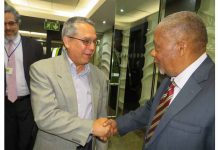Katiyo Clinic, located in the thick forests of Honde Valley in Mutasa district near Mozambique border, has become a helping hand for Mozambicans living with HIV.
It is one of the few health centres in the district offering free ART services to its clients.
The clinic used to be run by the Agricultural Rural Development Authority (ARDA) during the peak of the country`s agricultural sector in the country.
Later, ARDA surrendered the facility to the health ministry after production nosedived.

Since then, government has been managing to keep the medical facility operational in the process attracting Mozambicans to cross into the country to receive some services.
Most Mozambicans are now risking their lives to cross both flooded Pungwe and Rwiru rivers into the country to access their Anti Retroviral Therapy (ART) at the clinic.
Some of them walk from as far as Katandika in Manica province which is about 25 km from Katiyo border post.
With a staff complement of three; one female nurse, one male nurse and a general hand, the clinic is managing over 150 ART patients from both Mozambique and Zimbabwe.
The clinic only has less than five rooms which are subdivided into maternity wing, outpatient, and Opportunistic Infection (OI) section and drug dispensary.
According to a local nurse, Nomsa Masikati, Katiyo clinic, foreigners were being lured by quality and free services they were offering at the facility.
“We don’t charge anything everything is for free. Because we are just a few metres from the border, most Mozambicans visit this clinic, “she said.
Masikati said in some of the times, staff often seeks the services of translators to assist.
“We have villagers coming from as far as Katandika in Mozambique seeking treatment here at Katiyo clinic. At times we have to seek the services of a translator due to language barrier,” she said.
Mozambique uses Portuguese as its national language.
Besides ART services, the clinic also family planning and maternity related services.
Masikati said the clinic operates 24 hours a day; seven days a week and they only change duties amongst staff members when the need arises.
Although it has registered some successes on initiating ART patients from across the border, it has its fair share of challenges, chief among them in the distribution and monitoring of ART patients from Mozambique.
Another nurse, Choice Mwando said Pungwe and Rwiru rivers flood especially during the rainy season and this is a major challenge to both the clinic staff and patients.
He, however, said they have been receiving adequate supplies from government and were giving six months supplies to their clients from across the border until river levels drop.
“We have been receiving adequate supplies from government and we have been giving six months supply so that our patients from the border don’t skip their drugs in case both rivers are flooded,” said Mwando.
The clinic is also operating without electricity and this has impacted negatively on its operations, especially on the storage of vaccines that needs refrigeration.
“We don’t have electricity. Our transformer was struck by lightning in December 2017 and it’s yet to be repaired. We are using gas to cool our refrigerators at the moment. But when gas runs out, we have to transfer our drugs to Chisuko clinic where there is electricity,” said Mwando.
He also said they are overwhelmed and they need additional staff to complement their efforts.
Angeline Pedro, from Chief Njanji in Katandika Mozambique said health service delivery in their country was poor.
He said they prefer Katiyo clinic because they were being offered free and quality services.
“Pansi clinic in Mozambique does not have drugs. The services are so poor. So I prefer to walk three hours to Katiyo clinic for better services,“ said Pedro.
His sentiments were echoed by Angeline Chisiya Dominguez, a mother of one, who said they have no choice but to cross Pungwe River in search of better services at Katiyo clinic.
“There is nothing we can do besides crossing into Zimbabwe for better services. Most of the time our clinic does not have medicines and drugs but at Katiyo, everything is for free of charge,” Dominguez said, adding “although language is a barrier but we seek the services of those who speak both languages to assist local medical staff with translations”.
Munyaradzi Chimwara, who is Communications and External Relations Specialist for COMPASS Zimbabwe, the challenge at Katiyo is unique because it is established right at the border between Zimbabwe and Mozambicans.
He said the situation puts a strain on local resources because these facilities were designed for a specific population.
“Usually such facilities are designed for a geographically population of 1 000 people and it does not put into consideration foreigners from across the border. When you budget resources, you look at your own people. You don’t include foreigners. What it simply does is it puts a strain on the resources.
“Another challenge is that usually when drugs are dispensed especially on ART, they have a register of patients they are supposed to service. The unfortunate thing with health is that you can’t deny someone service when he comes, whether local or foreigner.
“It’s a matter of understanding the government policy on foreigners accessing health services locally. In other countries, even Zimbabweans pay to access medication in foreign countries.
“It’s a catch 22 situation for health personnel at Katiyo clinic. Its food for thought for government to look into the situation. I’m sure we have a lot of such facilities in areas such Mukumbura located near borders,” said Chimwara in an interview after the tour of Katiyo clinic.






